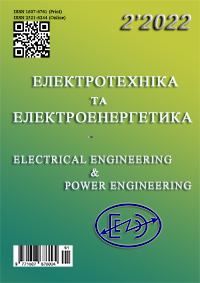Calculation of the electronic loading scheme for testing low voltage sources
DOI:
https://doi.org/10.15588/1607-6761-2022-2-4Keywords:
electronic load, MOSFET, solar cells, testing system, automationAbstract
Purpose. The introduction of electronic load for testing high-precision low-voltage sources (solar panels) requires careful review not only of the circuit design, but also thermal and mechanical design. The article considers the principle of creating and calculating the optimal solution for the implementation of electronic load.
Methodology. To achieve this goal, methods of analysis of modern electronic database, calculations of basic physical and electrical parameters and their modeling are used.
Findings. Based on the considered physical and circuit solutions for the implementation of the electronic load unit, a corresponding electrical circuit was developed. The transistors are controlled by four unipolar operational amplifiers integrated into the LM324 chip. Control of the electronic load unit is implemented by controlling the voltage at the positive feedback terminals, which is further stabilized by the TL431 chip. The device is powered by a source of DC stabilized current of 12 V (provides additional filtering from voltage fluctuations).
Originality. Modern advances in the development of solar cells and other low-voltage energy sources have led to the need to create compact and express systems for testing them, which cannot be implemented on existing solutions.
Practical value. Adherence to the indications and principles set out in this article will provide the load with the ability to work at high power, while maintaining good performance and reliability. The developed scheme allows to create a compass device for express testing of solar panels.
References
Mazumder, G.C., Biswas, P.R., Shams, N., et. al. (2016). Development of a computerized I-V-tracing system for solar PV module testing. International Jjournalof Scientific & Technology Research, 5, 6, 328-333. 10.11591/ijece.v11i3.pp2011-2018.
Beye, M.L., Wickramasinghe, T., Mogniotte, J.F., et. al. (2018). Active Gate Driver and Management of the Switching Speed of GaN Transistors during Turn-On and Turn-Off. Electronics, 10, 2, 106-119. 10.3390/electronics10020106.
Nel, G., Doorsamy, W. (2018). Development of an Intelligent Electronic Load Controller for Stand-Alone Micro-Hydropower Systems. 2018 IEEE PES/IAS PowerAfrica, 18202117. 10.1109/PowerAfrica.2018.8521133.
Ichino, S., Mawaki, T., Teramoto, A., et. al. (2017). Analysis of Random Telegraph Noise Behaviors to-ward Changes of Source Follower Transistor Opera-tion Conditions using High Accuracy Array Test Cir-cuit. IEICE Tech. Rep., 117, 260, 57-62.
Zaitsev, R.V., Kirichenko, M.V., Khrypunov, G.S., Prokopenko, D.S., Zaitseva, L.V. (2017). Develop-ment of hybrid solar generating module for high-efficiency solar energy station. First Ukraine Conference onElectricaland Computer Engineering, 360-364. 10.1109/UKRCON.2017.8100510.
Scherback,Ya.V., Plakhtiy, O.A., Nerubatskiy, V.P. (2017). Control characteristics of active four-quadrant converter in rectifier and recovery mode. TechnicalElectrodynamics, 6, 26-31. 10.15407/techned2017.06.026.
Tsibizov, A., Kovačević-Badstübner, I., Kakarla, B., et. al. (2020). Accurate Temperature Estimation of SiC Power Mosfets Under Extreme Operating Conditions. IEEE Transactionson Power Electronics, 35, 2, 1855-1865. 10.1109/TPEL.2019.2917221.
Eremenko, V.V., Sirenko, V.A., Gospodarev, I.A. (2017). Electron and phonon states localized near the graphene boundary. LowTemp. Phys., 43, 11, 1323-1331. 10.1063/1.5010320.
Zaitsev, R.V., Kopach, V.R., Kirichenko, M.V., et. al. (2010). Single-crystal silicon solar cell efficiency in-crease in magnetic field. FunctionalMaterials, 17, 4, 554-557.
Eremenko, V.V., Sirenko, V.A., Gospodarev, I.A., et. al. (2018). Electron spectra of graphene with local and extended defects. Journal ofPhysics: Conference Series, 969, 1, 012021. 10.1088/1742-6596/969/1/012021.
Kirichenko, M.V., Zaitsev, R.V., Dobrozhan, A.I., et. al. (2017). Adopting of DC magnetron sputtering method for preparing semiconductor films. 2017 IEEE International Young Scientists Forum on Ap-plied Physics and Engineering, 108-111.
Khrypunov, G.S., Kopach, G.I., Zaitsev, R.V., et. al. (2017). Flexible solar cells are based on underlying layers of CdTe obtained by magnetron sputtering. Journal ofNano- and Electronic Physics, 9, 2, 02008-1-02008-5. 10.21272/jnep.9(2).02008.
Taur, Y., Lin, H.-H. (2018). Modeling of DG MOSFET I – V Characteristics in the Saturation Re-gion. IEEE Transactionson Electron Devices, 65, 5, 1714-1720. 10.1109/TED.2018.2818943.
Bin Mohd Yusof, M.A., Tsukiji, N., Kobori, Y., et. al. (2018). A Study on Loop Gain Measurement Method Using Output Impedances in Operational Amplifier. J. Tech. Soc. Sci., 2, 3, 19-28. 10.1587/transcom.2017EBP3358.
Altun, M., Kuntman, H. (2008). Design of a fully differential current mode operational amplifier with improved input–output impedances and its filter ap-plications. International Journal of Electronics and Communications, 62, 3, 239-244. 10.1016/j.aeue.2007.03.020.
Khera, N., Tiwari, S. (2016). Prognostics of Power MOSFET due to unclamped inductive switching. 2016 IEEE 1st International Conference on Power Electronics, Intelligent Control and Energy Systems, 16672709. 10.1109/ICPEICES.2016.7853316.
Irving, B.T.,Panov, Y., Jovanovic, M.M. (2003). Small-signal model of variable-frequency flyback converter. Eighteenth Annual IEEE Applied Power Electronics Conference and Exposition, 7845817. 10.1109/APEC.2003.1179335
Downloads
Published
How to Cite
Issue
Section
License
Copyright (c) 2022 R.V. Zaitsev, M.V. Kirichenko, K.O. Minakova, R.S. Tomashevskii, V.O. Nikitin, M.M. Kharchenko

This work is licensed under a Creative Commons Attribution 4.0 International License.
Creative Commons Licensing Notifications in the Copyright Notices
Authors who publish with this journal agree to the following terms:
Authors retain copyright and grant the journal right of first publication with the work simultaneously licensed under aCreative Commons Attribution License that allows others to share the work with an acknowledgement of the work's authorship and initial publication in this journal.
Authors are able to enter into separate, additional contractual arrangements for the non-exclusive distribution of the journal's published version of the work (e.g., post it to an institutional repository or publish it in a book), with an acknowledgement of its initial publication in this journal.
Authors are permitted and encouraged to post their work online (e.g., in institutional repositories or on their website) prior to and during the submission process, as it can lead to productive exchanges, as well as earlier and greater citation of published work.

